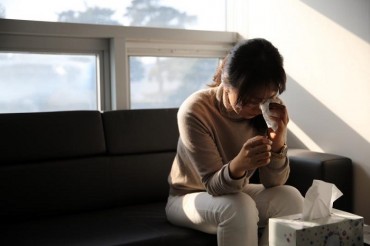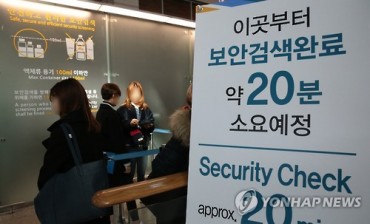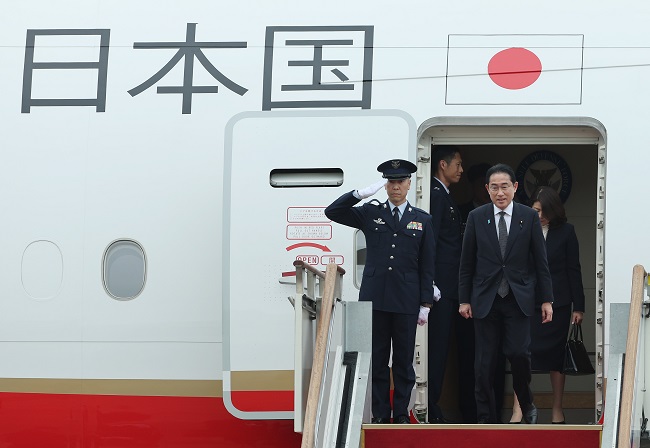
Japanese Prime Minister Fumio Kishida arrives at Seoul Air Base, south of Seoul, on May 7, 2023. (Yonhap)
SEOUL, May 7 (Korea Bizwire) — Japanese Prime Minister Fumio Kishida took steps Sunday to reciprocate President Yoon Suk Yeol’s commitment to improving bilateral ties, as he accepted a South Korean team’s inspection of the planned release of radioactive water from the crippled Fukushima nuclear power plant and acknowledged the past pain of Koreans under Japanese colonial rule.
The water release and Japan’s attitude about its 1910-45 colonial occupation were the main points that were closely watched as Yoon and Kishida held their second summit in less than two months to add momentum to the recent warming of bilateral ties.
The thaw began in March after the Yoon administration decided to compensate Korean victims of Japanese wartime forced labor without the involvement of Japanese firms, a decision Kishida lauded as “courageous.”
Kishida returned the goodwill Sunday by announcing he will accept a visit by a team of South Korean experts to inspect the planned release of the contaminated water.
Amid South Korean calls for a sincere apology, he also acknowledged the pain of forced labor victims.
“My heart aches over the fact that many people had an extremely painful and sad experience in harsh conditions at the time,” he said, before adding he was speaking in a personal capacity.
Critics said the remark still falls short of a direct apology.
Kishida reciprocated Yoon’s visit to Tokyo in March, marking the full revival of “shuttle diplomacy” between the two countries’ leaders after a 12-year hiatus caused largely by historical enmity stemming from Japan’s colonial rule of the Korean Peninsula.
The thaw between Seoul and Tokyo is likely to aid the U.S.’ drive to promote trilateral cooperation with its Asian allies to confront shared challenges, but the perceived splintering of the world into competing geopolitical blocs could shrink the room for great-power cooperation over North Korean issues, the analysts noted.
“From tensions across the Taiwan Strait to the war in Ukraine and the North Korean conundrum, complex uncertainties could have the potential to develop and descend into a vicious cycle,” said Nam Chang-hee, professor of international politics at Inha University.
“Under the clouds of the uncertainties, countries may converge on the need to maximize the space for cooperation whenever they can.”
Their shared external challenges have apparently served as a wake-up call for the two Asian democracies that have been caught in a raft of spats, including over Japan’s colonial-era misdeeds, territorial claim to Korea’s easternmost islets of Dokdo and plan to discharge radioactive water from the crippled Fukushima nuclear power plant, to name a few.
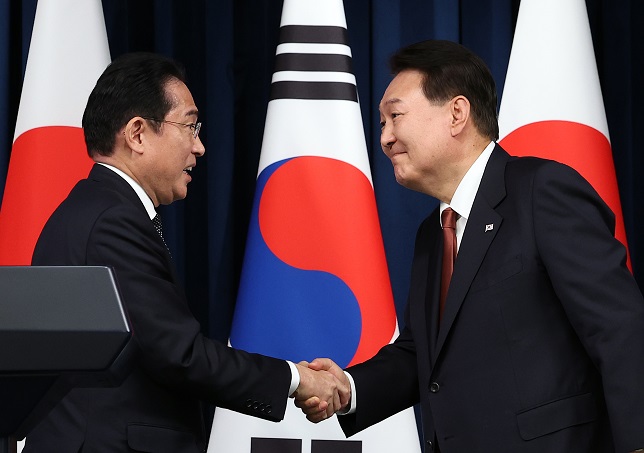
President Yoon Suk Yeol (R) and Japanese Prime Minister Fumio Kishida shake hands after giving a joint press conference following their summit at the presidential office in Seoul on May 7, 2023. (Yonhap)
Chief among the challenges are growing North Korean nuclear and missile threats.
Pyongyang has been doubling down on its menacing weapons projects, including those to develop tactical nuclear weapons, and an assortment of ballistic missiles that put South Korea, Japan and the U.S. mainland within range.
To curb the threats from the North, Washington has been pushing to cement trilateral cooperation with its two Asian allies, leading Seoul to take a giant step in March to normalize relations with Tokyo: an announcement on a solution to the thorny issue of compensation for Korean victims of Japan’s wartime forced labor.
The solution — under which a government-affiliated foundation is to offer compensation to victims without contributions from Japanese firms — was politically risky at home.
But in its wake, the two nations have seen the normalization of their once-underutilized intelligence-sharing pact, their trade relations back on track, and the resumption of their working-level dialogues and summit diplomacy.
Yoon has defended his push for a thaw with Japan, stressing the two countries are not in a “zero-sum” relationship, in which one side’s gain means the other side’s loss, particularly under the “grave” international circumstances.
“The South Korea-Japan relationship can become a win-win relationship when (the two countries) make more efforts together, and it should definitely do,” Yoon said during a Cabinet meeting in March.
Kishida, on his part, has displayed his desire to improve relations with South Korea by visiting Seoul earlier than expected.
His move came on the back of a rise in his approval ratings and his Liberal Democratic Party’s win in last month’s local elections.
He is the first Japanese premier to visit Seoul in a shuttle diplomacy format since then Prime Minister Yoshihiko Noda visited the South Korean capital in October 2011.
The resumption of the shuttle diplomacy came ahead of a trilateral summit among Yoon, U.S. President Joe Biden and Kishida expected to take place on the margins of the Group of Seven summit in Hiroshima, Japan, later this month.
The trilateral summit is likely to be a venue where the leaders may further deepen their security cooperation against North Korean threats, as well as joint efforts to promote stability in the Indo-Pacific region.
“The restoration of the shuttle diplomacy could lead to a prominent milestone in the efforts to cement trilateral cooperation,” Nam of Inha University said.
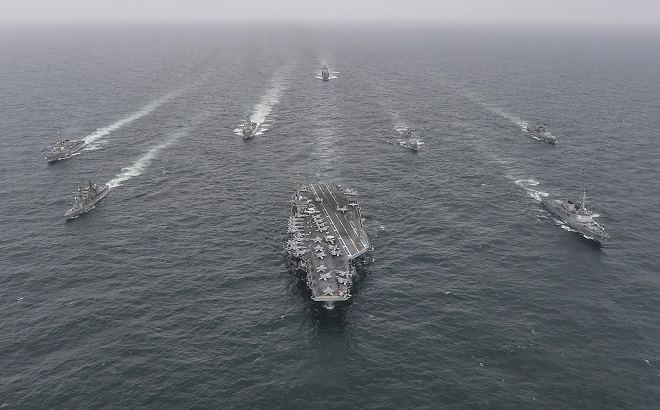
This file photo, released by the South Korean Navy, shows South Korean, U.S. and Japanese warships engaging in a maritime exercise in waters south of the Korean Peninsula on April 4, 2023.
Progress in the three-way cooperation is already palpable as the three nations agreed to hold missile defense and anti-submarine exercises regularly to tackle North Korean threats during their senior-level defense talks last month.
Their leaders have also agreed to share missile warning data “in real time.”
Tightening tripartite collaboration among the U.S. and its Asian allies came in the context of an intensifying Sino-U.S. rivalry and growing tensions between the West and Russia over Moscow’s war in Ukraine.
The growing geopolitical realignment could make it more difficult to promote cooperation among great powers in leading the North to give up its nuclear weapons and choose a path of peace on the Korean Peninsula, analysts said.
“Especially in the wake of the war in Ukraine, friction between the U.S. and Russia and between the U.S. and China has dimmed the prospects for their cooperation on the North Korean quandary,” said Choo Jae-woo, professor of Chinese Studies at Kyung Hee University.
But hopes emerged that the possible resumption of a trilateral summit among South Korea, China and Japan could help ease geopolitical tensions in Northeast Asia and promote cooperation among them.
The three countries had held eight rounds of three-way summit talks since their first gathering in December 2018.
Since their last summit in the Chinese city of Chengdu in December 2019, tripartite gatherings have not been held amid historical feuds between Seoul and Tokyo, and the COVID-19 pandemic.
Uncertainties still linger over the future trajectory of relations between Seoul and Tokyo, as Japan continues to lay claim to Dokdo with its right-wing politicians periodically visiting the Yasukuni Shrine seen as a symbol of their country’s past militarism.
(Yonhap)




